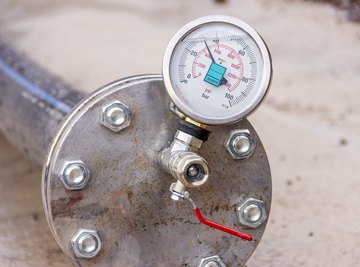
When you check the weather, if you're like most people, what interests you most are the things that dictate your dress: Whether or not precipitation of some sort is likely to fall out of the sky during your outdoor exposure, what the air temperature is and whether it's windy.
Depending on where you live and the time of year, you may also check (sometimes with dread) to see the relative humidity level, to make sure you're hydrated enough for the sweating that's likely to follow given a high reading.
Most people are aware of the phenomenon of atmospheric (usually called barometric) pressure because they hear it mentioned as a standard feature of weather forecasts, but most folks don't get as far as investigating what the relationship is, and why the air experiences pressure changes at all. Don't winds blow horizontally, whereas pressure is measured from above as a kind of "pushing"?
Pressure is a quantity in physics that applies to almost every imaginable physical process. It relates force F to area A in a host of contexts, is expressed and defined mathematically in its simplest form as P = F/A. It plays an especially vital role in the field of fluid dynamics. (A fluid consists of matter in a liquid or a gas state.) The atmosphere around you is a fluid, and it exerts a lot more pressure on you and everything else than you might think.
What Is Pressure?
Formally, pressure is a measurement of the effect of the spreading of force (measured in newtons, or N, in the standard international measurement system) across some real or mathematically defined surface (measured in square meters or m2). You may have encountered physics problems already in which a force (such as gravity, or yourself) acts on and moves an object with mass, but pressure is different in that it in effect describes the dilution or concentration of force.
-
Imagine two different solid boxes, each with a volume V of 10 m3 (cubic meters) and filled with a uniform solid material with a density ρ
half that of water, or 0.5 kg/L, or (500 kg/m3). One box is 1 m long, 1 m wide and 10 m tall, while the other is 2.5 m long, 2.5 m wide and 1.6 m tall. Neither box is to be rotated from its position. If you wanted to be sure an ancient-looking nearby platform could support either box, but could only pick one of the two to confirm this, which one would you choose?
The masses of the objects are the same because their volumes and densities are the same (ρ = m/V, so m = ρV = (500 kg/m3)(10 m3) = 5,000 kg. Given that the acceleration owing to gravity on Earth's surface is 9.8 m/s2, the force (or weight) of each box is therefore (5,000 kg)(9.8 m/s2) = 49,000 N.
However, compare the areas over which these respective masses are distributed: The first box has a base (length times width) of 1 m × 1 m = 1 m2, while the other box has a base of 2.5 × 2.5 = 6.25 m2. Since pressure equals force divided by area, the narrow box, with less than one-sixth of the base area to work with as the second box, will exert 6.25 times as much pressure on the platform as its partner will. Thus if the ramshackle platform can support the first box, it should be able to hold the second one alone as well – provided you can lift them up there!
Pressure Units and Terminology
In the above example, the pressure of the first box on any surface on which it rests is (49,000 N)/(1 m2) and that of the second is (49,000 N)(6.25 m2). The units of pressure in the standard system is thus the N/m2, more commonly called the pascal (Pa). Because this works out to be such a small amount in the real world, the kilopascal (kPa) is far more commonly used.
The pressure of the atmosphere at the surface of Earth is about 101,325 Pa, or 101.3 kPa. Because of the means by which humans determine pressure, however, a number of other units are in everyday use. One is the torr, also known as millimeters of mercury (mm Hg). (Any curiosities you have about why this metal was selected will be satisfied in a moment.) 101.3 kPa, also called 1 atm for reference, equates to 760 torr by this standard. Since 1 inch = 25.4 mm, 760 mm Hg = (760/25.4) = 29.92 in Hg. Finally, 1 millibar = 0.001 atm, so atmospheric pressure in millibars = 1,013 mbar.
Finally, what about those pounds per square inch (psi or lb/in2) typically used for measuring tire pressure in the United States? After invoking the conversions between lb and kg and between in and m, you can show that 101.3 kPa = 14.7 lb/in2. Given that the recommended minimum car tire pressure is only about 30 psi, what does this suggest about your intuition concerning the "negligible" weight, and therefore pressure, of air?
How Pressure Is Measured
A manometer is a device that measures air pressure using a container with a "U"-shaped tube open at one or both ends. In a closed manometer, a sample of gas is introduced into one end, which is then capped. Then, a fluid of known density is poured into the other end. The fluid will stop moving when the pressure of the gas trapped between the cap and the fluid together with the pressure at the bottom of the fluid column on that side matches the pressure of air plus the pressure of the fluid column on the open side.
The height of the fluid on the open side will be higher on that side when air pressure is less than the gas pressure and lower on the open side when the air pressure exceeds the gas pressure. You can use this height difference to calculate the gas pressure.
Since P = F/A = mg/A, m = ρV and V = Ah for a cylindrical tube (i.e., volume = area times height), it can be shown that the pressure created by a vertical column of fluid is ρgh, where h = height in meters. This pressure represents the positive or negative difference between the gas pressure and atmospheric pressure.
- Man- is the Latin root for the word meaning hand," which is also where "manipulate" comes from; one easy way to convey the concept of pressure if limited to nonverbal language would be using your hand to press gently against another person's.
- A barometer is a type of pressure gauge used specifically to measure atmospheric pressure.
- The manual device used to measure blood pressure in a healthcare setting is called a sphygmomanometer, with sphyg- translating loosely to "squeeze." This is because a cuff must be inflated against the arm to a level above body blood pressure in order to properly measure it; they must literally squeeze your arm to do so.
Pressure and Weather
Atmospheric pressure is not constant, and it varies within a typical range just as temperature and other geophysical quantities do. A separate discussion in itself, this pressure is a reliable indicator of impending weather. When a low-pressure system enters an area, the result is usually clouds, wind and precipitation, whereas a high-pressure system usually produces fair and calm weather. (Get that? "High pressure" ends in "calm" ... only in the wacky world of physics!)
References
About the Author
Kevin Beck holds a bachelor's degree in physics with minors in math and chemistry from the University of Vermont. Formerly with ScienceBlogs.com and the editor of "Run Strong," he has written for Runner's World, Men's Fitness, Competitor, and a variety of other publications. More about Kevin and links to his professional work can be found at www.kemibe.com.
